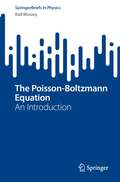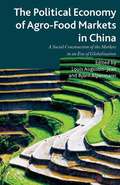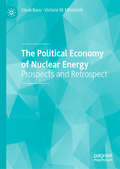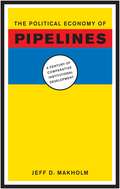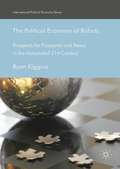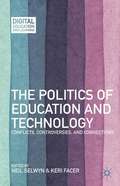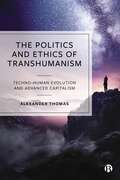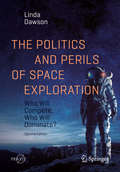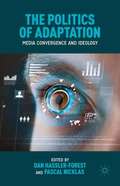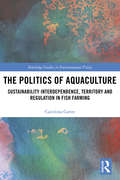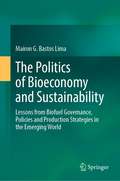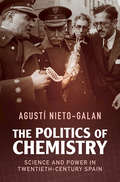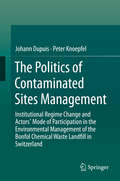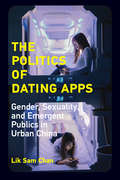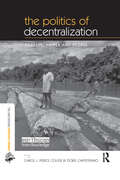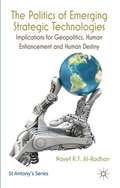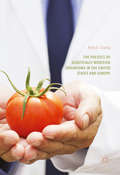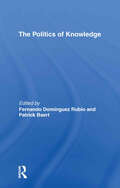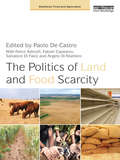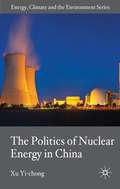- Table View
- List View
The Poem Electric: Technology and the American Lyric
by Seth PerlowAn enlightening examination of the relationship between poetry and the information technologies increasingly used to read and write it Many poets and their readers believe poetry helps us escape straightforward, logical ways of thinking. But what happens when poems confront the extraordinarily rational information technologies that are everywhere in the academy, not to mention everyday life?Examining a broad array of electronics—including the radio, telephone, tape recorder, Cold War–era computers, and modern-day web browsers—Seth Perlow considers how these technologies transform poems that we don&’t normally consider &“digital.&” From fetishistic attachments to digital images of Emily Dickinson&’s manuscripts to Jackson Mac Low&’s appropriation of a huge book of random numbers originally used to design thermonuclear weapons, these investigations take Perlow through a revealingly eclectic array of work, offering both exciting new voices and reevaluations of poets we thought we knew.With close readings of Gertrude Stein, Frank O&’Hara, Amiri Baraka, and many others, The Poem Electric constructs a distinctive lineage of experimental writers, from the 1860s to today. Ultimately, Perlow mounts an important investigation into how electronic media allows us to distinguish poetic thought from rationalism. Posing a necessary challenge to the privilege of information in the digital humanities, The Poem Electric develops new ways of reading poetry, alongside and against the electronic equipment that is now ubiquitous in our world.
The Poisson-Boltzmann Equation: An Introduction (SpringerBriefs in Physics)
by Ralf BlosseyThis brief book introduces the Poisson-Boltzmann equation in three chapters that build upon one another, offering a systematic entry to advanced students and researchers. Chapter one formulates the equation and develops the linearized version of Debye-Hückel theory as well as exact solutions to the nonlinear equation in simple geometries and generalizations to higher-order equations. Chapter two introduces the statistical physics approach to the Poisson-Boltzmann equation. It allows the treatment of fluctuation effects, treated in the loop expansion, and in a variational approach. First applications are treated in detail: the problem of the surface tension under the addition of salt, a classic problem discussed by Onsager and Samaras in the 1930s, which is developed in modern terms within the loop expansion, and the adsorption of a charged polymer on a like-charged surface within the variational approach. Chapter three finally discusses the extension of Poisson-Boltzmann theory to explicit solvent. This is done in two ways: on the phenomenological level of nonlocal electrostatics and with a statistical physics model that treats the solvent molecules as molecular dipoles. This model is then treated in the mean-field approximation and with the variational method introduced in Chapter two, rounding up the development of the mathematical approaches of Poisson-Boltzmann theory. After studying this book, a graduate student will be able to access the research literature on the Poisson-Boltzmann equation with a solid background.
The Political Economy of Agro-Food Markets in China
by Louis Augustin-Jean Björn AlpermannChina's agricultural production and food consumption have increased tremendously, leading to a complete evolution of agro-food markets. The book is divided into two parts; the first part reviews the theoretical framework for the 'social construction of the markets,' while the second part presents the implication for the agro-food markets in China.
The Political Economy of Nuclear Energy: Prospects and Retrospect
by Victoria W. Miroshnik Dipak BasuUsing primarily Russian sources, this book explains the political and economic aspects of nuclear power. The nuclear fuel cycle is described, from the mining of natural uranium to the ultimate power generation, and to reprocessing to produce plutonium which is essential for both electricity generation and for weapons production. Historical aspects of nuclear developments in Germany, the USA, India, China and the Soviet Union are also considered and explained. The book then proceeds to argue that Russia is more powerful today in its nuclear weapons system and delivery than ever before, and that it is precisely this which has provoked President Trump to cancel the strategic nuclear weapons reduction treaty.
The Political Economy of Pipelines: A Century of Comparative Institutional Development
by Makholm Jeff D.With global demand for energy poised to increase by more than half in the next three decades, the supply of safe, reliable, and reasonably priced gas and oil will continue to be of fundamental importance to modern economies. Central to this supply are the pipelines that transport this energy. And while the fundamental economics of the major pipeline networks are the same, the differences in their ownership, commercial development, and operation can provide insight into the workings of market institutions in various nations. Drawing on a century of the world's experience with gas and oil pipelines, this book illustrates the importance of economics in explaining the evolution of pipeline politics in various countries. It demonstrates that institutional differences influence ownership and regulation, while rents and consumer pricing depend on the size and diversity of existing markets, the depth of regulatory institutions, and the historical structure of the pipeline businesses themselves. The history of pipelines is also rife with social conflict, and Makholm explains how and when institutions in a variety of countries have controlled pipeline behavior--either through economic regulation or government ownership--in the public interest.
The Political Economy of Robots
by Ryan KigginsThis collection examines implications of technological automation to global prosperity and peace. Focusing on robots, information communication technologies, and other automation technologies, it offers brief interventions that assess how automation may alter extant political, social, and economic institutions, norms, and practices that comprise the global political economy. In doing so, this collection deals directly with such issues as automated production, trade, war, state sanctioned robot violence, financial speculation, transnational crime, and policy decision making. This interdisciplinary volume will appeal to students, scholars and practitioners grappling with political, economic, and social problems that arise from rapid technological change that automates the prospects for human prosperity and peace.
The Political Spectrum: The Tumultuous Liberation of Wireless Technology, from Herbert Hoover to the Smartphone
by Thomas Winslow HazlettFrom the former chief economist of the FCC, a remarkable history of the U.S. government’s regulation of the airwaves Popular legend has it that before the Federal Radio Commission was established in 1927, the radio spectrum was in chaos, with broadcasting stations blasting powerful signals to drown out rivals. In this fascinating and entertaining history, Thomas Winslow Hazlett, a distinguished scholar in law and economics, debunks the idea that the U.S. government stepped in to impose necessary order. Instead, regulators blocked competition at the behest of incumbent interests and, for nearly a century, have suppressed innovation while quashing out-of-the-mainstream viewpoints. Hazlett details how spectrum officials produced a “vast wasteland” that they publicly criticized but privately protected. The story twists and turns, as farsighted visionaries—and the march of science—rise to challenge the old regime. Over decades, reforms to liberate the radio spectrum have generated explosive progress, ushering in the “smartphone revolution,” ubiquitous social media, and the amazing wireless world now emerging. Still, the author argues, the battle is not even half won.
The Politics Of Education And Technology
by Neil Selwyn Keri FacerThis book examines the struggles over technology's use in education, digging into what the purpose of education is, how we should achieve it, who the stakeholders are, and whose voices win out. Drawing on theoretical and empirical work, it lays bare the messy realities of technology use in education and their implications for contemporary society.
The Politics and Ethics of Transhumanism: Techno-Human Evolution and Advanced Capitalism
by Alexander ThomasAvailable open access digitally under CC-BY-NC-ND licenceTranshumanism is a philosophy which advocates for the use of technology to radically enhance human capacities.This book interrogates the promises of transhumanism, arguing that it is deeply entwined with capitalist ideology. In an era of escalating crisis and soaring inequality, it casts doubt on a utopian techno-capitalist narrative of unending progress. In critiquing the transhumanist project, the book offers an alternative ethical framework for the future of life on the planet.As the debates around the advancement of AI and corporate-led digital technologies intensify, this is an important read for academics as well as policy makers .
The Politics and Perils of Space Exploration: Who Will Compete, Who Will Dominate? (Springer Praxis Books)
by Linda DawsonThis book examines the U.S. space program’s triumphs and failures in order to assess what constitutes a successful space policy. Using NASA and the space industry’s complex history as a guide, it draws global lessons about space missions and the trends we can expect from different nations in the next decade and beyond. Space exploration has become increasingly dependent on cooperation between countries as well as the involvement of private enterprise. This book thus addresses issues such as: Given their tenuous history, can rival countries work together? Can private enterprise fill NASA’s shoes and provide the same expertise and safety standards? Written by a former NASA Aerodynamics Officer at Houston Mission Control working on the Space Shuttle program, the second edition of this book provides updated information on U.S. space policy, including the new strategy to return to the Moon prior to traveling to Mars. Additionally, it takes a look at the formation of the Space Force as a military unit, as well as the latest developments in private industry. Overall, it is a thought-provoking resource for both space industry professionals and space enthusiasts.
The Politics of Adaptation
by Dan Hassler-Forest Pascal NicklasIn the 21st century, the parallel movements of media convergence and globalization have reshaped our understanding of media boundaries. The rise of digital culture has increased our access to narrative media, while also providing new ways of engaging with them. But, at the same time, global media corporations have intensified their power over these media and the channels through which they reach us. This book brings together a broad range of scholarly approaches to the challenges and opportunities of adaptation studies in this new era. Together, they focus on the political and ideological tensions that underlie and shape processes of adaptation and cultural transformation in the age of media convergence.
The Politics of Aquaculture: Sustainability Interdependence, Territory and Regulation in Fish Farming (Routledge Studies in Environmental Policy)
by Caitríona CarterAquaculture is increasingly complementing global fisheries and is relevant to ocean and freshwater health, biodiversity and food security, as well as coastal management, tourism and natural heritage. This book makes the case for treating the governance of this industry as meriting attention in its own right, abandoning the polemic discussions of fish farming and opening up new ways for debating its past, present and future. Developing and applying an original analytical framework for studying fish farming aquaculture, embedded into larger theory about the changing political system, the author generates and compares new data on the governance of aquaculture. Detailed case studies are presented of Scottish salmon, Aquitaine trout in France and seabass and seabream in Greece. The book shows how ecological issues are related to economic and social issues, as well as interdependences between territories, public and private regulation and different knowledge forms, demonstrating that these are creating alternative approaches for sustainability governance. It provides a deeper understanding of the political aspects of governing European aquaculture, including how it both is structured by and is structuring politics. It is aimed at advanced students, researchers and professionals in aquaculture and fisheries, as well as those with a broader interest in sustainability politics and sustainability governing practices.
The Politics of Bioeconomy and Sustainability: Lessons from Biofuel Governance, Policies and Production Strategies in the Emerging World
by Mairon G. Bastos LimaThis book addresses the underexposed political dimensions of bioeconomy promotion. Who wins and who loses? How are institutions being shaped, and by whom? Drawing from experiences since the earlier days of biofuels promotion, it explores in unprecedented detail the global drive away from fossil fuels and towards a biomass-based economy.Multipurpose agriculture gains ever more traction as countries create new bio-based value chains – or, rather, value webs. Governance, in this regard, proves to be key for steering developments towards inclusive agri-food-biomass systems instead of fueling just a handful of “flex crops” ridden with social equity and other environmental issues.Based on a rich global-level analysis of bioeconomy promotion and three in-depth case studies of key emerging economies (Brazil, India and Indonesia), the book also innovatively examines sustainability politics in Global South democracies.Ultimately, this book is about finding the politics for a fairer bioeconomy in the years and decades to come.
The Politics of Chemistry: Science and Power in Twentieth-Century Spain (Science in History)
by Agustí Nieto-GalanAgustí Nieto-Galan argues that chemistry in the twentieth century was deeply and profoundly political. Far from existing in a distinct public sphere, chemical knowledge was applied in ways that created strong links with industrial and military projects, and national rivalries and international endeavours, that materially shaped the living conditions of millions of citizens. It is within this framework that Nieto-Galan analyses how Spanish chemists became powerful ideological agents in different political contexts, from liberal to dictatorial regimes, throughout the century. He unveils chemists' position of power in Spain, their place in international scientific networks, and their engagement in fierce ideological battles in an age of extremes. Shared discourses between chemistry and liberalism, war, totalitarianism, religion, and diplomacy, he argues, led to advancements in both fields.
The Politics of Contaminated Sites Management
by Johann Dupuis Peter KnoepfelBy the end of the 1970s, contaminated sites had emerged as one of the most complex and urgent environmental issues affecting industrialized countries. The authors show that small and prosperous Switzerland is no exception to the pervasive problem of sites contamination, the legacy of past practices in waste management having left some 38,000 contaminated sites throughout the country. This book outlines the problem, offering evidence that open and polycentric environmental decision-making that includes civil society actors is valuable. They propose an understanding of environmental management of contaminated sites as a political process in which institutions frame interactions between strategic actors pursuing sometimes conflicting interests. In the opening chapter, the authors describe the influences of politics and the power relationships between actors involved in decision-making in contaminated sites management, which they term a "wicked problem. " Chapter Two offers a theoretical framework for understanding institutions and the environmental management of contaminated sites. The next five chapters present a detailed case study on environmental management and contaminated sites in Switzerland, focused on the Bonfol Chemical Landfill. The study and analysis covers the establishment of the landfill under the first generation of environmental regulations, its closure and early remediation efforts, and the gambling on the remediation objectives, methods and funding in the first decade of the 21st Century. The concluding chapter discusses the question of whether the strength of environmental regulations, and the type of interactions between public, private, and civil society actors can explain the environmental choices in contaminated sites management. Drawing lessons from research, the authors debate the value of institutional flexibility for dealing with environmental issues such as contaminated sites.
The Politics of Dating Apps: Gender, Sexuality, and Emergent Publics in Urban China (The Information Society Series)
by Lik Sam ChanAn examination of dating app culture in China, across user demographics--straight women, straight men, queer women, and queer men.In this exploration of dating app culture in China, Lik Sam Chan argues that these popular mobile apps are not merely a platform for personal relationships but also an emerging arena for gender and queer politics. Chan examines the opportunities dating apps present for women's empowerment and men's performances of masculinity, and he links experiences of queer dating app users with their vulnerable position as sexual minorities. He finds that dating apps are both portals to an exciting virtual world of relational possibilities and sites of power dynamics that reflect the heteronormativity and patriarchy of Chinese society.
The Politics of Decentralization: Forests, Power and People (The Earthscan Forest Library)
by Doris Capistrano Carol J. Pierce ColferDecentralization is sweeping the world and having dramatic and far-reaching impacts on resource management and livelihoods, particularly in forestry. This book is the most up-to-date examination of the themes, experiences and lessons learned from decentralization worldwide. Drawing on research and support from all of the major international forestry and conservation organizations, the book provides a balanced account that covers the impact of decentralization on resource management worldwide, and provides comparative global insights with wide implications for policy, management, conservation and resource use and planning. Topics covered include forest governance in federal systems, democratic decentralization of forests and natural resources, paths and pitfalls in decentralization and biodiversity conservation in decentralized forests. The book provides in-depth case studies of decentralization from Bolivia, Ghana, Indonesia, Russia, Scotland, Switzerland, Uganda and the US, as well as highlights from federal countries including Australia, Brazil, Canada, India and Malaysia. It also addresses the critical links between the state, forests, communities and power relations in a range of regions and circumstances, and provides case examples of how decentralization has been viewed and experienced by communities in Guatemala, Philippines and Zimbabwe. The Politics of Decentralization is state-of-the-art coverage of decentralization and is essential for practitioners, academics and policy-makers across forestry and the full spectrum of natural resource management.
The Politics of Disaster Management in China
by Gang ChenIn China s 4,000-year-long history and modern development, natural disaster management has been about not only human combat against devastating natural forces, but also institutional building, political struggle, and economic interest redistribution among different institutional players. A significant payoff for social scientists studying disasters is that they can reveal much of the hidden nature of political and economic processes and structures, particularly those in non-democracies, which are normally covered up with great care. This book reviews the problems and progress in the politics of China s disaster management. It analyses the factors in China s governance and political process that restrains its capacity to manage disasters. The book helps the audience better understand the dynamic relationship among various interest groups and civic forces in modern China s disaster politics, with special emphasis on the process of pluralization, decentralization and fragmentation. "
The Politics of Emerging Strategic Technologies
by Nayef R.F. Al-RodhanEmerging technologies hold great promise but also pose major challenges to global politics, national and international security, human dignity and human destiny. This book examines the latest innovations, key trends and geopolitical and human implications of emerging strategic technologies such as Biotechnology, Nanotechnology and Artificial Intelligence. The potential use and misuse of these technologies in human enhancement (physical and cognitive) is considered to be one of the major challenges of our time. Nayef Al-Rodhan argues that human enhancement and the future evolution into transhumans is inevitable. To prepare for these potential existential threats, the global community is urged to establish strict moral and legal guidelines that balance the need for innovation with the guarantee of dignity for all
The Politics of Environmental Performance
by Detlef JahnAs the world faces the prospect of climate change, nuclear disasters, and water scarcity, it is clear that environmental degradation is an increasingly serious challenge with economic and social consequences. In this book, Detlef Jahn analyzes political processes in a macro-comparative study in order to estimate the role of politics in the field of environmental performance in twenty-one OECD countries. His model demonstrates various styles of politics used to combat environmental degradation. He finds that economic and environmental performance are still closely linked, and that moving towards a service society does not by itself solve the environmental challenge. The close relationship of these areas was made strikingly clear in the economic crisis of the new millennium. He argues that economic globalization fosters environmental deterioration, and undermines efforts in domestic politics and international coordination to improve the environmental record.
The Politics of Genetically Modified Organisms in the United States and Europe
by Kelly A. ClancyThis book examines the puzzle of why genetically modified organisms continue to be controversial despite scientific evidence declaring them safe for humans and the environment. What explains the sustained levels of resistance? Clancy analyzes the trans-Atlantic controversy by comparing opposition to GMOs in the United Kingdom, Germany, Poland, Spain, and the United States, examining the way in which science is politicized on both sides of the debate. Ultimately, the author argues that the lack of labeling GMO products in the United States allows opponents to create far-fetched images of GMOs that work their ways in to the minds of the public. The way forward out of this seemingly intractable debate is to allow GMOs, once tested, to enter the market without penalty—and then to label them.
The Politics of Knowledge.
by Patrick Baert Fernando Domínguez RubioSocial scientists often refer to contemporary advanced societies as ‘knowledge societies’, which indicates the extent to which ‘science’, ‘knowledge’ and ‘knowledge production’ have become fundamental phenomena in Western societies and central concerns for the social sciences. This book aims to investigate the political dimension of this production and validation of knowledge. In studying the relationship between knowledge and politics, this book provides a novel perspective on current debates about ‘knowledge societies’, and offers an interdisciplinary agenda for future research. It addresses four fundamental aspects of the relation between knowledge and politics: • the ways in which the nature of the knowledge we produce affects the nature of political activity • how the production of knowledge calls into question fundamental political categories • how the production of knowledge is governed and managed • how the new technologies of knowledge produce new forms of political action. This book will be of interest to students of sociology, political science, cultural studies and science and technology studies.
The Politics of Land and Food Scarcity (Earthscan Food and Agriculture)
by Paolo De CastroIn recent years the issue of food security has become centre stage in the global agenda. Since the 2007/8 food price crisis, a number of works have been published on the topic, addressed from various perspectives: economic, social and cultural, environmental, agronomic and climate change. Very rarely is there a comprehensive approach, which also includes the crucial issue of politics. Through a multidisciplinary approach, this book provides an overview of the new global challenges connected with land, food supply and agriculture. It also contributes to engagement in a new global food policy, through a political analysis of land and food scarcity, including 'land grabs' by affluent countries in poorer nations. It does not simply raise the debate; rather it aspires to move forward the debate that has started with the G20 meetings. It discusses how national governments, local agricultural policies and supranational entities are facing the new scenario of feeding a growing population when land resources are limited and subject to competing claims.
The Politics of Military Coalitions
by Scott WolfordMilitary coalitions are ubiquitous. The United States builds them regularly, yet they are associated with the largest, most destructive, and consequential wars in history. When do states build them, and what partners do they choose? Are coalitions a recipe for war, or can they facilitate peace? Finally, when do coalitions affect the expansion of conflict beyond its original participants? The Politics of Military Coalitions introduces newly collected data designed to answer these very questions, showing that coalitions - expensive to build but attractive from a military standpoint - are very often more (if sometimes less) than the sum of their parts, at times encouraging war while discouraging it at others, at times touching off wider wars while at others keeping their targets isolated. The combination of new data, new formal theories, and new quantitative analysis will be of interest to scholars, students, and policymakers alike
The Politics of Nuclear Energy in China
by Xu Yi-ChongExplores the history and challenges of nuclear energy development in China, across five main areas: politics, economics, environment, technology transfer and the nuclear fuel cycle. It emphasizes the political challenges in developing a set of long-term national strategies to ensure speedy, safe and secure nuclear energy development.

